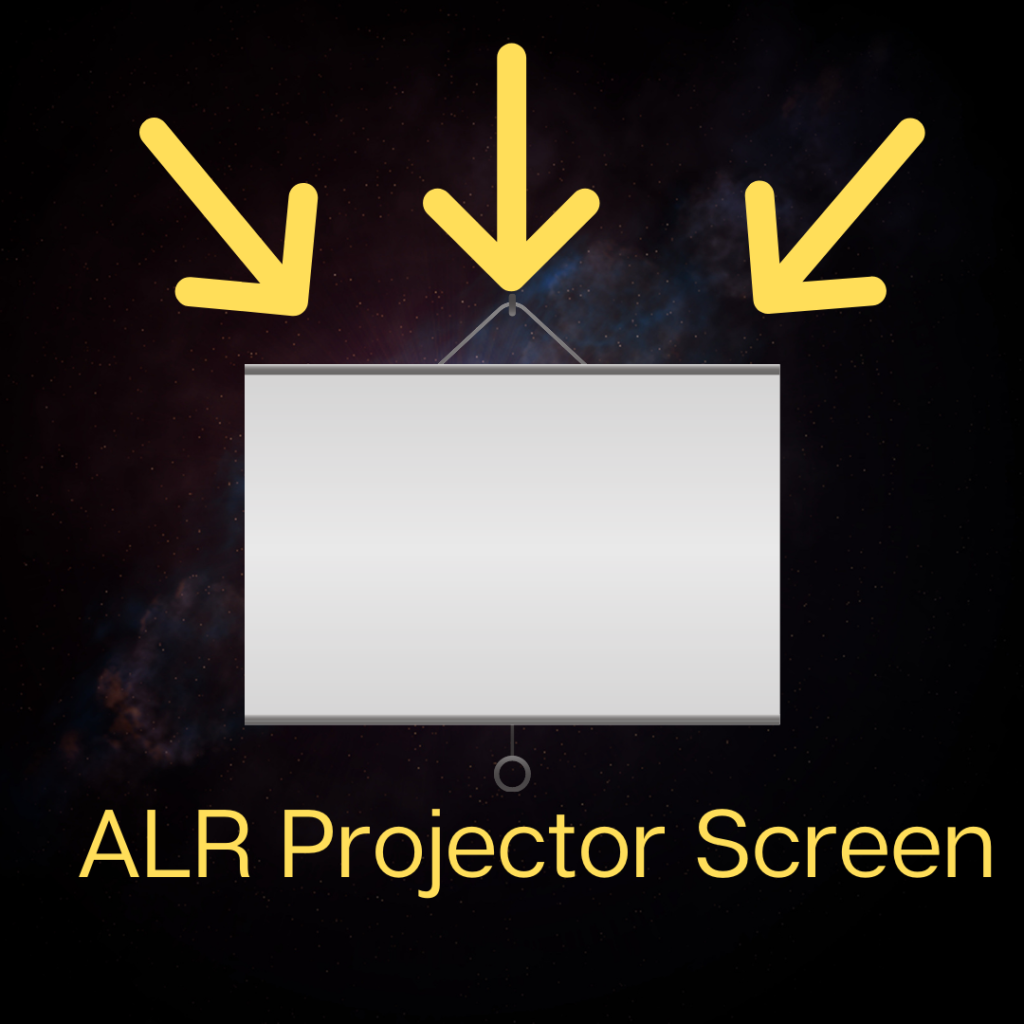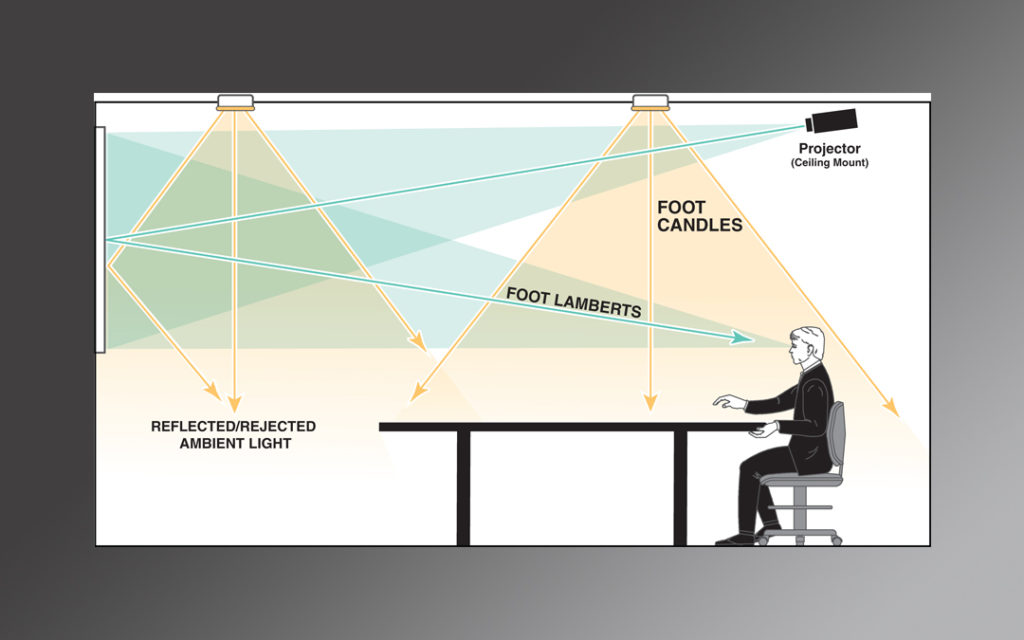What is ALR?
ALR stands for Ambient Light Rejection. If we define ALR, it is a fabric that furnishes directional acceptance and re-reflectance of light within defined limits. From orthogonal or perpendicular sources, the ALR surface responds in a good way like a projector that is one of its goals.

Another goal of the ALR surface is to limit the re-reflection of light coming from off-axis sources. These axis sources can be lighting and windows.
ALR Projector screen
ALR screen is an ambient light rejection screen that reflects light to the audience. You need to keep the position of the projector and screen in a way that the projector light gets bounced towards the audience. The other ambient light in the room reflects in some other direction. ALR screen phenomenon only works if you adjust the screen in a way that ambient light is hitting the screen and projector from different directions. You can use it to project videogames or something else even without shutting lights.
Regular projectors can work better with the ALR screen. As with a regular projector you need to shut the lights off but with an ALR screen, you don’t need to do it. You can see everything clearly even in the presence of ambient light when using ambient light rejecting projector screen.
Understanding ALR

ALR screens make the image brighter by reflecting light on the viewer. There are some specific things you need to understand about ALR. Let’s discuss Uses for ALR Projector Screening and some other understandings:
- Using an ALR screen
There is a need for proper placement of light projector, and screen to maximize the ALR screen‘s effect. It works best when you place it like this so that ambient light isn’t hitting the screen and projector from the same direction. When mounting projectors get fixed on the ceiling, the screen is set relative to the projector. You can set all these things only once so keep the direction right and left all other parts on the ALR screen. It’ll maximize the brightness and minimize the ambient light or redirect it.
- Working
Ambient light weakens the projector light if it’s less than a certain threshold of brightness in lumens. As the ambient makes the projector light weaker it becomes stronger and clearer to your eyes. Like any good lighting setup, ALR also reflects and redirects lights to the audience through some correct angle. You can take the example of ambient light from a bright flashlight. In the daytime, you don’t find flashlights brighter while at night you do.
- Great for Conference Rooms
While using ALR might be good or perfect for even less bright projectors like mini or camping ones. This fabric makes the ALR screen a perfect business projector screen that makes it work in a conference room or classroom setting. In such settings, the lights are necessary so with ALR you can get a bright image or projection on the screen. Within defined constraints, it works well even with lesser bright projectors.
- Goals
Like from the light of a projector projecting an image or video, it has a goal of responding excellently to light. It responds superbly to light from perpendicular sources or orthogonal angles limiting the re-reflection of light coming from off-axis sources. The off-axis sources sending light names such as ambient light include in-room light bulbs, lamps, mood lighting, open windows, etc. ALR screens make viewing comfortable and viewable, especially in the case of short-throw projectors.
- Main Design Points
There are several points that you should keep in mind while searching for ALR screens. The first design consideration is that projector and screen should have lights coming from different directions. Secondly, the angle of the screen and projector should be such that it deflects ambient light somewhere else away from the audience. The screening method is better than others in which you increase the lumen count of the projector.
- Position
An ambient light rejection screen is a special fabric that maximizes the viewing capability of the image even in brightness. The screen also has some constraints which means it requires proper projector location relative to the viewer or audience. There is a need for proper lighting fixtures in the room. It provides maximum viewing quality and satisfaction by rejecting its ambient light. The location of the projector is the main thing as ALR screens have unique properties. It is critical to position your display device according to the screen.
Frequently Asked Questions
Are ALR screens worth it?
ALR screens are worth spending money on in some situations and places. In schools and conference rooms where ambient light sources are necessary ALR screens can be a good option. ALR screen can provide you benefits in such places by accommodating more ambient light. These screens provide a better quality of images even in the lights. You don’t need to dim the lights to have more viewing quality of the projected image on the screen.
How do I clean my ALR screen?
If you want to clear the ALR screen, follow these steps:
- Gently blot with a damp microfiber cloth rather than rubbing it
- Wipe the screen gently in an up-down motion
- With the use of a solution of equal parts Formula 409 and water, you can remove heavily soiled or sticky parts.
- Don’t spray the formula on-screen material directly.
How do ALR screens work?
ALR screen reflects the light to the audience and increases the brightness of the projected image. It redirects the ambient lights away from viewers. By increasing the brightness and decreasing the ambient light it provides high-quality images even under lights in the room.
Conclusion
In situations where you need high-performance, and brighter images even in ambient lights, you should go for ALR screens. These can be good options to provide the results of the realistic high-resolution image without dimming the lights. These features of ALR screens make it an ideal choice among people who want to represent their ideas and thoughts in the best professional way even under normal lighting conditions.

Thomas is a leading contributor and loves anything to do with tech! After attending college for Computer Programming, he continued his interest in the digital world and then went on to start a now 10-year-old retail tech/gadget shop. When he isn’t working in his technology shop he is reviewing and learning more in-depth through his youtube channel.
